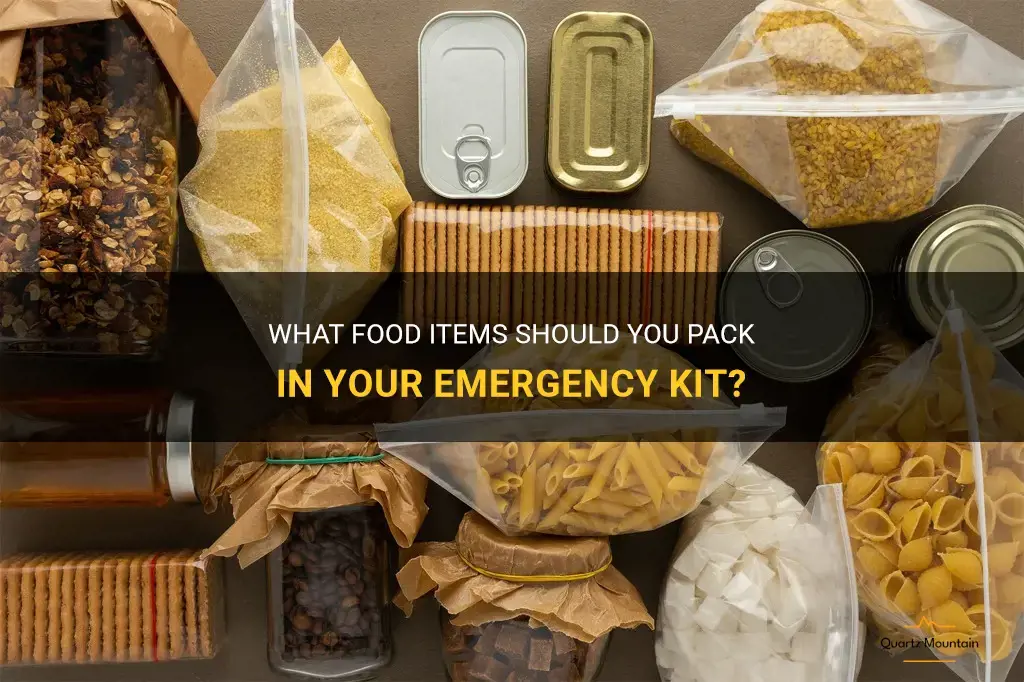
When it comes to preparing for emergencies, most people think about essential items like water, flashlights, and a first aid kit. However, one crucial aspect that often gets overlooked is food. In times of crisis or natural disasters, access to food may become limited or even non-existent. That's why it's vital to include food items in your emergency kit. Whether you're facing a power outage, a severe storm, or a global pandemic, having a supply of non-perishable food can make all the difference in your ability to sustain yourself and your family. In this article, we will explore some food items that you should pack in your emergency kit to ensure you're ready for anything life throws your way.
| Characteristics | Values |
|---|---|
| High in calories | Around 2,000-2,400 calories per day |
| Non-perishable | Does not spoil quickly |
| Nutrient-dense | Contains essential vitamins and minerals |
| Easy to prepare | Does not require cooking or refrigeration |
| Long shelf-life | Can be stored for an extended period of time |
| Lightweight and compact | Easy to carry and transport in emergency |
| Allergy-friendly | Suitable for common food allergies |
| Familiar and palatable | Liked by most people and easy to eat |
| Diverse | Includes a variety of food groups |
| Water-rich | Helps maintain hydration in emergency |
What You'll Learn
- What non-perishable food items should be included in an emergency kit?
- How much food should be packed in an emergency kit to sustain each person for a specified period of time?
- Are there any dietary restrictions or considerations that should be taken into account when selecting food for an emergency kit?
- How often should the emergency kit's food supply be rotated to ensure freshness and effectiveness?
- What types of packaging or storage containers are best suited for storing food in an emergency kit?

What non-perishable food items should be included in an emergency kit?
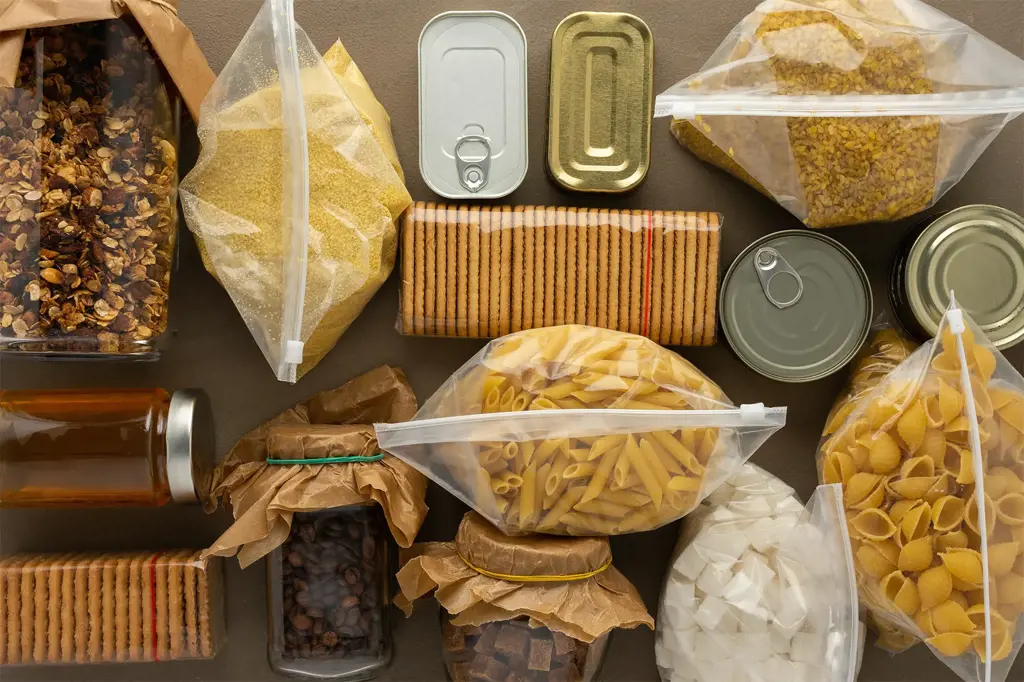
In times of emergency, such as natural disasters or other unforeseen circumstances, having an emergency kit stocked with non-perishable food items is essential. Non-perishable foods can be stored for long periods of time without spoiling, making them ideal for emergency situations when access to fresh food may be limited or non-existent. When preparing an emergency kit, it is important to include a variety of non-perishable food items that are nutritious and can sustain your energy levels. Here are some examples of non-perishable food items that should be included in an emergency kit:
- Canned goods: Canned foods are a staple in emergency kits as they have a long shelf life and can provide essential nutrients. Some examples include canned fruits, vegetables, soups, and proteins such as tuna or chicken. Look for low-sodium options to promote heart health.
- Dried fruits and nuts: Dried fruits, such as raisins or apricots, and nuts, like almonds or peanuts, are great sources of energy and can be easily stored in an emergency kit. They are also packed with essential nutrients like fiber, vitamins, and minerals.
- Granola bars and energy bars: These compact and high-energy snacks are a convenient option for emergency situations. Look for bars that are low in added sugars and high in protein and fiber to keep you feeling full and energized.
- Peanut butter: Peanut butter is an excellent source of protein and healthy fats. It can be stored for a long time and is versatile enough to be spread on crackers or used as a dip for fruits and vegetables.
- Whole grain crackers: Whole grain crackers are a good source of carbohydrates and can be paired with canned meats or spreads like peanut butter or cheese for an easy and satisfying meal.
- Ready-to-eat cereals: Choose whole grain cereals that are low in sugar and high in fiber. These can be eaten with shelf-stable milk alternatives or simply as a snack.
- Shelf-stable milk alternatives: Non-perishable milk alternatives, such as powdered or UHT (ultra-high temperature) milk, can be reconstituted with water and used in various recipes or enjoyed on their own.
- Instant noodles or pasta: These items are quick and easy to prepare, requiring only boiling water to make a hot and comforting meal. Look for whole grain options for added nutritional benefits.
- Dried beans and legumes: Dried beans and legumes, such as lentils or chickpeas, are not only nutritious but also provide a good source of protein and fiber. They can be soaked and cooked when needed.
- Multivitamins: It is important to include a supply of multivitamins in your emergency kit to ensure you are getting essential nutrients even if fresh food is scarce.
When assembling your emergency kit, it is important to consider the specific dietary needs and preferences of all household members. Additionally, be sure to check expiration dates regularly and rotate items to ensure the contents of your emergency kit remain fresh and usable. By including a variety of nutritious and non-perishable food items in your emergency kit, you can ensure that you and your family will have enough sustenance to stay nourished during times of crisis.
Essential Packing Guide for Glacier National Park Adventures
You may want to see also

How much food should be packed in an emergency kit to sustain each person for a specified period of time?
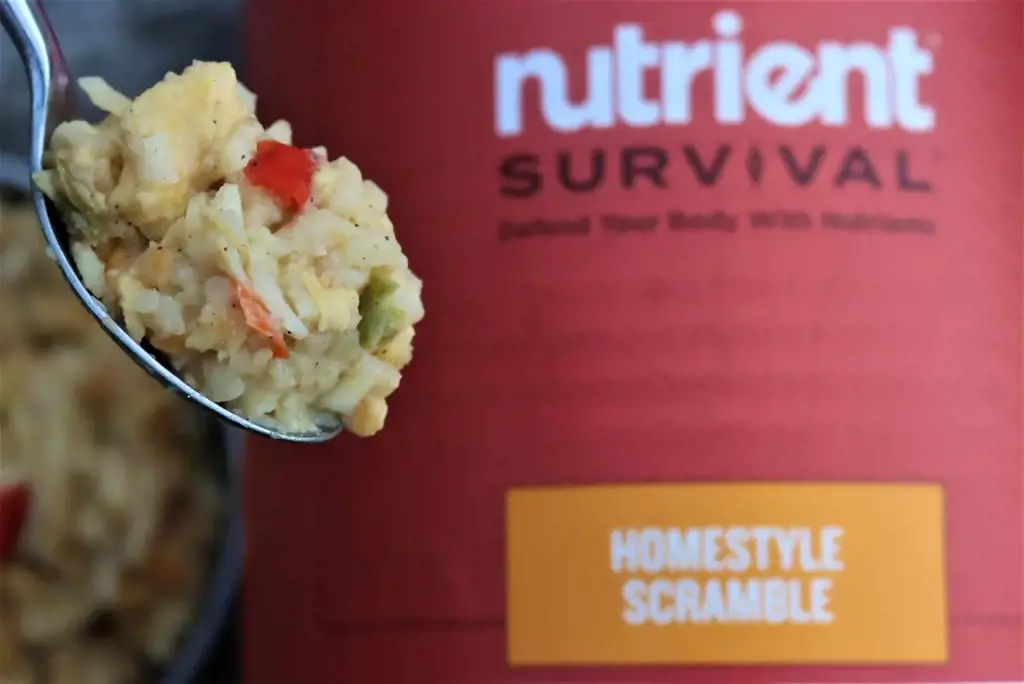
In preparing for emergencies, it is crucial to have an emergency kit that includes sufficient food to sustain each person for a specified period of time. The amount of food needed will depend on several factors, such as the number of people in the household and the duration of the emergency. This article will guide you through the process of determining how much food should be packed in an emergency kit to ensure that you and your loved ones are adequately nourished during an emergency situation.
Step 1: Calculate the number of calories needed per person.
The first step in determining how much food to pack is to calculate the number of calories needed per person per day. According to the U.S. Department of Agriculture (USDA), an adult of average height and weight requires about 2,000 to 2,500 calories per day to meet their energy needs. However, this number may vary depending on factors such as age, gender, activity level, and overall health. It is recommended to consult with a healthcare professional to determine the appropriate calorie requirements for each individual in your household.
Step 2: Determine the duration of the emergency.
The next step is to determine the duration of the emergency for which you are preparing. This could range from a few days to a couple of weeks, depending on the type of emergency and the availability of outside resources. It is important to have a clear understanding of the expected timeframe to ensure that you pack enough food to last throughout the entire duration.
Step 3: Multiply the daily calorie requirement by the number of days.
Once you have determined the daily calorie requirement and the duration of the emergency, you can calculate the total number of calories needed for each person during that period. Simply multiply the daily calorie requirement by the number of days. For example, if a person requires 2,000 calories per day and you are preparing for a two-week emergency, the total number of calories needed would be 2,000 x 14 = 28,000 calories.
Step 4: Select a variety of nutrient-dense foods.
When packing your emergency food kit, it is important to focus on selecting nutrient-dense foods that will provide essential vitamins and minerals. Include a mix of non-perishable foods such as canned fruits and vegetables, whole grain cereals, nuts, seeds, dried fruits, and protein sources like canned beans, tuna, or chicken. It is also beneficial to include foods that require minimal preparation and can be eaten directly from the packaging, as access to cooking facilities may be limited during an emergency.
Step 5: Consider dietary restrictions and preferences.
Take into account any dietary restrictions or preferences when selecting the foods for your emergency kit. If someone in your household has allergies or follows a specific diet, such as vegetarian or gluten-free, make sure to include suitable food options that meet their dietary needs. It is also advisable to pack a sufficient supply of drinking water to ensure hydration throughout the emergency period.
Example: Let's put all the steps into practice with the following example. Imagine you have a family of four, including two adults and two children, and you are preparing for a one-week emergency. Considering an average daily calorie requirement of 2,000 calories per adult and 1,500 calories per child, the total number of calories needed for the week would be:
2,000 calories x 7 days = 14,000 calories for each adult
1,500 calories x 7 days = 10,500 calories for each child
For the family of four, the total number of calories needed for the week would be:
14,000 calories x 2 adults + 10,500 calories x 2 children = 49,000 calories
By following this example, you can apply the same calculation method to determine the appropriate amount of food to pack in your emergency kit, customizing it based on the number of individuals and their specific calorie requirements.
In conclusion, packing an emergency kit with sufficient food is crucial for sustaining each person during an emergency. By calculating the daily calorie requirement, determining the duration of the emergency, and selecting nutrient-dense foods, you can effectively pack an emergency kit that will provide essential nourishment and ensure the well-being of your household during an unexpected event.
The Ultimate Packing List for Your Epic Vegas Trip
You may want to see also

Are there any dietary restrictions or considerations that should be taken into account when selecting food for an emergency kit?
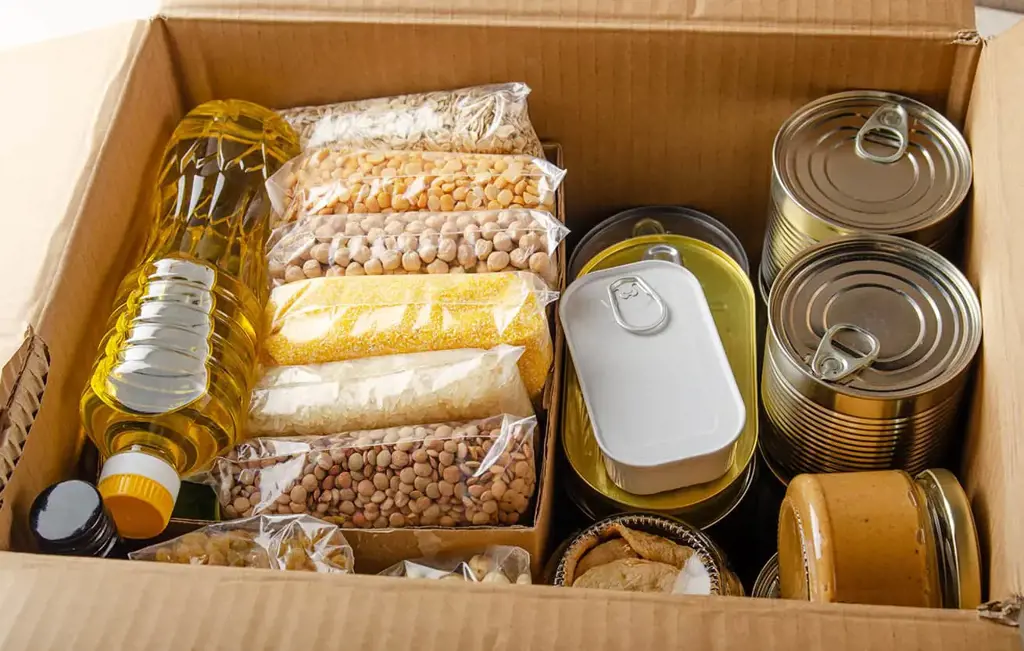
When preparing an emergency kit, it is important to consider any dietary restrictions or considerations that may apply to you or your family members. This will ensure that you have the necessary food and supplies to sustain yourselves during an emergency situation. In this article, we will discuss some common dietary restrictions and considerations and provide guidance on how to select food for your emergency kit.
Allergies and Intolerances:
If you or your family members have allergies or intolerances to certain foods, it is crucial to avoid including those items in your emergency kit. Common food allergens include peanuts, tree nuts, shellfish, dairy products, eggs, soy, and wheat. Make sure to read the labels carefully and choose food items that are free from these allergens. Consider opting for allergen-friendly options such as nut-free granola bars or gluten-free crackers.
Medical Conditions:
If you or your family members have specific medical conditions, it is important to choose food that accommodates those needs. For example, individuals with diabetes should have access to glucose tablets or snacks with a low glycemic index. People with high blood pressure should opt for low-sodium food options. If you have a medical condition that requires a specific diet, consult with your healthcare provider to determine the best options for your emergency kit.
Special Diets:
If you follow a special diet such as vegetarian, vegan, or kosher, it is crucial to consider these dietary restrictions when selecting food for your emergency kit. Look for options that fit your dietary preferences and provide the necessary nutrients. Canned beans, tofu, plant-based protein bars, and shelf-stable grains can be good choices for vegetarians and vegans. Kosher emergency food options are available that meet the requirements of Jewish dietary laws.
Food Preferences:
Even if you don't have any specific dietary restrictions, it is still important to consider your food preferences when selecting items for your emergency kit. Choose food that you and your family members enjoy eating. This will help maintain morale and ensure that the emergency food is consumed when necessary. Include a variety of foods to provide balanced nutrition and prevent taste fatigue.
Shelf Life and Storage:
When selecting food for your emergency kit, pay attention to the shelf life and storage requirements of the items. Choose food that has a long shelf life and does not require refrigeration. Look for non-perishable options such as canned fruits and vegetables, canned meats, dried fruits, nuts, and seeds. It is also important to rotate your emergency food periodically to ensure that it stays fresh and does not expire.
In conclusion, selecting food for an emergency kit should take into account any dietary restrictions or considerations. Consider allergies, medical conditions, special diets, food preferences, and shelf life when choosing items for your emergency kit. By planning ahead and selecting appropriate food, you can ensure that you and your family have the necessary sustenance during an emergency situation.
Examples:
- Sarah is preparing her emergency kit and has a severe peanut allergy. She makes sure to choose food items that are free from peanuts. She selects granola bars labeled as peanut-free and opts for snack options that are not produced in facilities that handle peanuts. This ensures that she can safely consume the food in her emergency kit.
- John follows a gluten-free diet and wants to make sure he has gluten-free options in his emergency kit. He selects gluten-free crackers, rice, canned vegetables, and gluten-free protein bars. He also includes a list of gluten-free recipes that can be prepared using the canned items. This allows him to maintain his dietary needs even during an emergency.
Remember, each person's dietary needs may vary, so it is essential to customize your emergency food kit according to your specific requirements. Consult with a healthcare provider or dietitian for personalized guidance.
Nutritious and Delicious: Packing the Perfect Lunch to Shed Pounds
You may want to see also

How often should the emergency kit's food supply be rotated to ensure freshness and effectiveness?
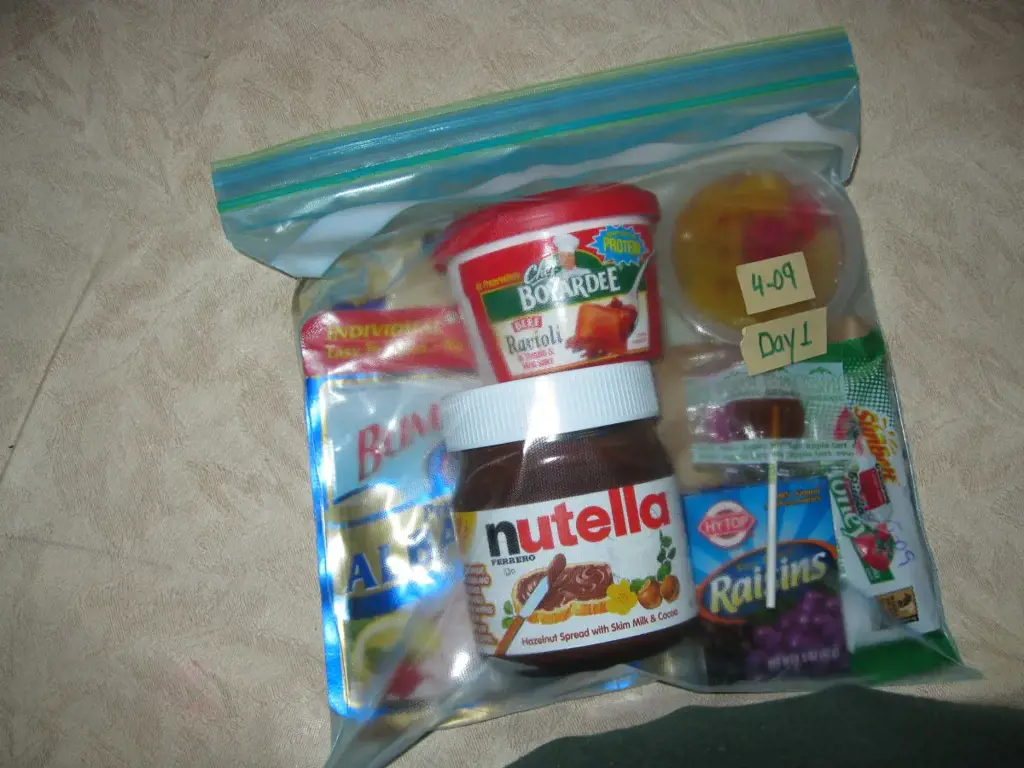
Emergency preparedness is essential for any individual or family to ensure readiness in the face of unforeseen circumstances. One crucial aspect of emergency preparedness is maintaining emergency kits, which includes a food supply to sustain individuals during an emergency situation. However, to ensure the freshness and effectiveness of the food supply, rotation is crucial. So, how often should the emergency kits' food supply be rotated?
The shelf life of emergency food can vary depending on the type of food and its packaging. It is necessary to check the expiration dates on the packaging of each food item. Typically, most emergency food kits have a shelf life of 5 to 25 years, with freeze-dried meals having the longest shelf life. However, it is vital to rotate the food supply regularly to maintain freshness and nutritional value.
The frequency of rotation depends on several factors, including the shelf life of the food items and the specific recommendations provided by the manufacturer. A general rule of thumb is to check and rotate the food supply every six months to a year. This ensures that the food remains fresh and safe to consume during an emergency.
It is important to follow a systematic process when rotating the food supply. First, remove all food items from the emergency kit and inspect them individually. Look for any signs of damage, such as torn packaging, dents in cans, or moisture buildup. Dispose of any damaged or expired items immediately.
Next, organize the food items based on their expiration dates, placing those with the earliest dates towards the front. This method, known as the First In, First Out (FIFO) system, ensures that the oldest items are used first, minimizing waste and ensuring freshness.
When replacing food items, select ones with a similar shelf life to the items being replaced. This strategy helps to maintain a consistent rotation schedule and allows for easier planning and inventory management. Additionally, it is advisable to keep a record of the food items and their expiration dates to track their rotation more effectively.
Regularly consuming and replacing emergency food items also allows individuals to become familiar with the taste and preparation process. In emergency situations, stress levels may be high, and having familiarity with the food can help alleviate additional anxiety.
Furthermore, periodic inspection of the emergency kit is essential to ensure that other crucial items, such as water, medical supplies, and tools, are in proper working condition. Replace any expired or damaged items promptly and restock any items that may have been used or are running low.
To summarize, the emergency kits' food supply should be rotated every six months to a year, depending on the shelf life of the food items and the manufacturer's recommendations. Following a systematic process, such as the FIFO system, ensures that the food remains fresh and safe to consume during an emergency. Additionally, keeping records and periodically inspecting the emergency kit are crucial for overall preparedness. By maintaining a properly rotated and stocked food supply, individuals can ensure their readiness in the face of emergencies.
Essential Items to Include in Your Period Kit for Any Situation
You may want to see also

What types of packaging or storage containers are best suited for storing food in an emergency kit?
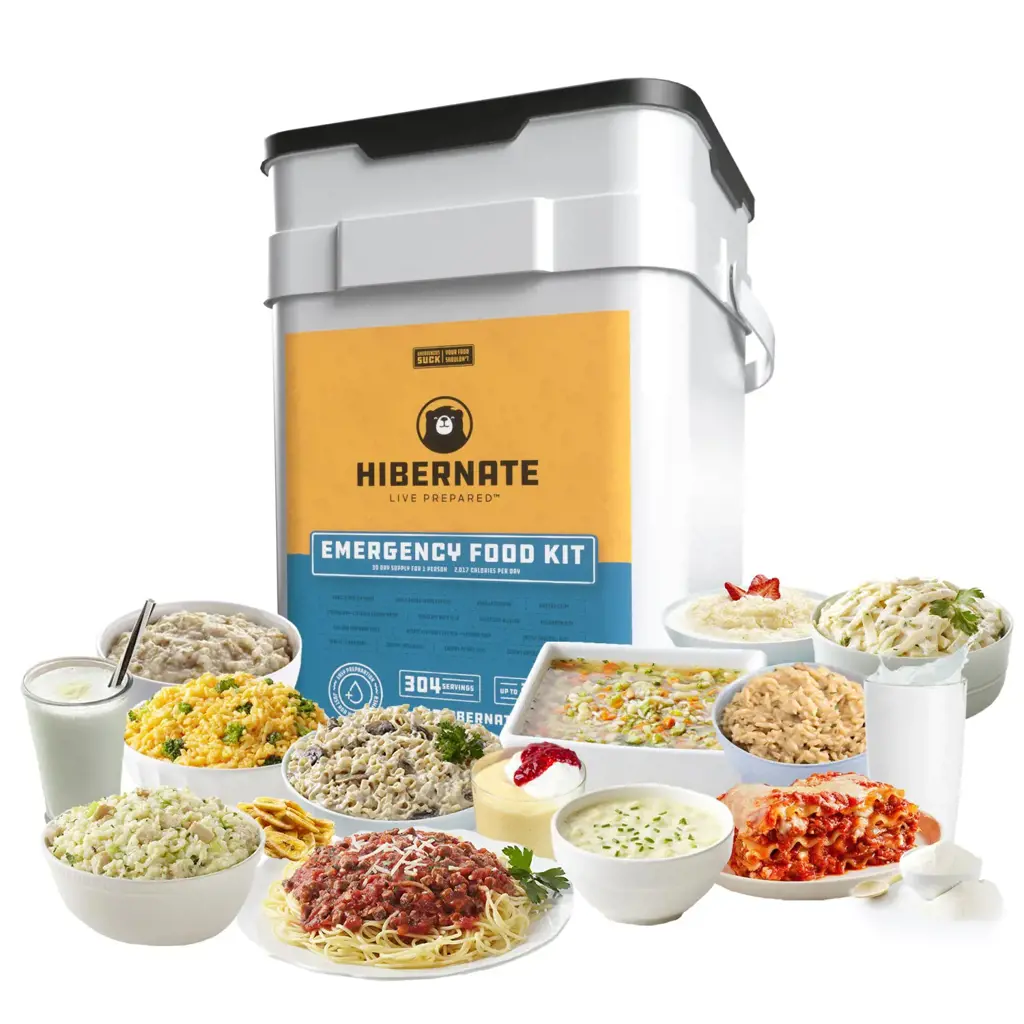
When preparing an emergency kit, it's important to consider the type of packaging or storage containers that are best suited for storing food. The right containers can help keep your food fresh for longer and prevent contamination. In this article, we will discuss the different types of packaging and storage containers that are ideal for emergency food storage.
- Mylar Bags: Mylar bags are a popular choice for long-term food storage. These bags are made from a polyester film that provides a barrier against light, oxygen, moisture, and pests. Mylar bags are often used in conjunction with oxygen absorbers to remove oxygen from the packaging. This helps prolong the shelf life of the food and prevents spoilage. Mylar bags are lightweight, durable, and easy to seal using a heat sealer. They are available in various sizes and can be used to pack both dry and dehydrated food items.
- Food-Grade Plastic Containers: Food-grade plastic containers are another excellent choice for storing food in emergency kits. These containers are made from high-quality plastic that is safe for storing food. Look for containers that are BPA-free and have airtight lids to keep the food fresh. It's important to choose containers that are opaque or have UV protection to prevent light from degrading the food. These containers are ideal for storing canned goods, dry staples like rice and beans, and even homemade dehydrated meals.
- Glass Jars: Glass jars are a classic choice for food storage. They are non-porous, meaning they won't absorb odors or flavors from the food. Glass jars are easy to clean and can be reused multiple times. They are especially useful for storing items like nuts, dried fruits, or homemade preserves. The transparent nature of glass jars allows you to see the contents at a glance, making it easier to identify what you have in your emergency kit.
- Vacuum Sealed Bags: Vacuum sealing is a popular method for preserving food freshness. Vacuum-sealed bags remove air from the packaging, preventing oxygen from oxidizing the food. This method helps extend the shelf life of food significantly. Vacuum-sealed bags are commonly used for storing dehydrated meals, jerky, or freeze-dried food. While vacuum-sealed bags are not as durable as Mylar bags, they are a suitable option for shorter-term emergency kits.
- Metal Cans: Metal cans are widely used for commercially packed foods and are an excellent option for emergency food storage. Canned goods have a long shelf life and can withstand extreme conditions. They are durable, portable, and require no special packaging. However, it's important to rotate canned goods regularly to ensure they are consumed before their expiration date.
When storing food in emergency kits, it's essential to consider the shelf life of the items and package them appropriately. Labeling the containers with the date of storage and contents can help you keep track of their freshness. Additionally, choosing containers that are stackable can save valuable space in your emergency kit.
In conclusion, there are various types of packaging and storage containers that are suited for storing food in an emergency kit. Mylar bags, food-grade plastic containers, glass jars, vacuum-sealed bags, and metal cans all have their advantages and are suitable for different types of food storage. By using the right packaging and containers, you can ensure that your emergency food stays fresh, safe, and ready to eat when needed.
What to Pack for a Week of Death Vacation
You may want to see also
Frequently asked questions
When packing food for your emergency kit, it is important to choose non-perishable items that can be stored for long periods of time without spoiling. Some good options include canned goods such as beans, vegetables, and fruits. Other options can include dried fruits, nuts, granola bars, and jerky. It is also important to pack foods that require little to no preparation and can be eaten without the need for cooking or refrigeration.
The amount of food you should pack in your emergency kit will depend on the number of people in your household and how long you anticipate needing to use the kit. As a general rule, it is recommended to have at least a three-day supply of food per person. This can be calculated by multiplying the number of people in your household by the number of meals needed per day (typically three) and then multiplying that by the number of days you anticipate needing the kit for.
It is not recommended to pack perishable foods in your emergency kit as they can spoil quickly without refrigeration. Perishable foods such as meat, dairy products, and fresh fruits and vegetables should be avoided. Instead, opt for non-perishable items that have a long shelf life and do not require refrigeration. These types of foods will stay safe to eat for longer periods of time and can be relied upon in emergency situations.







